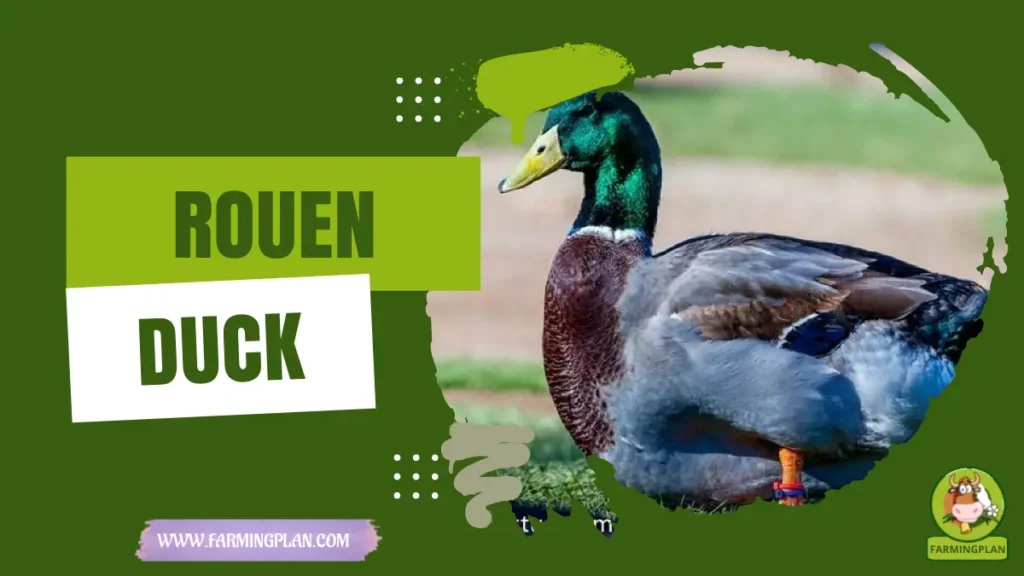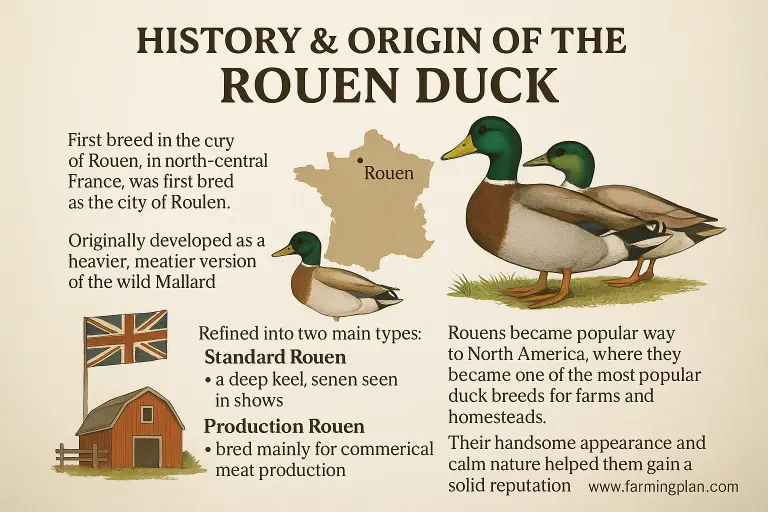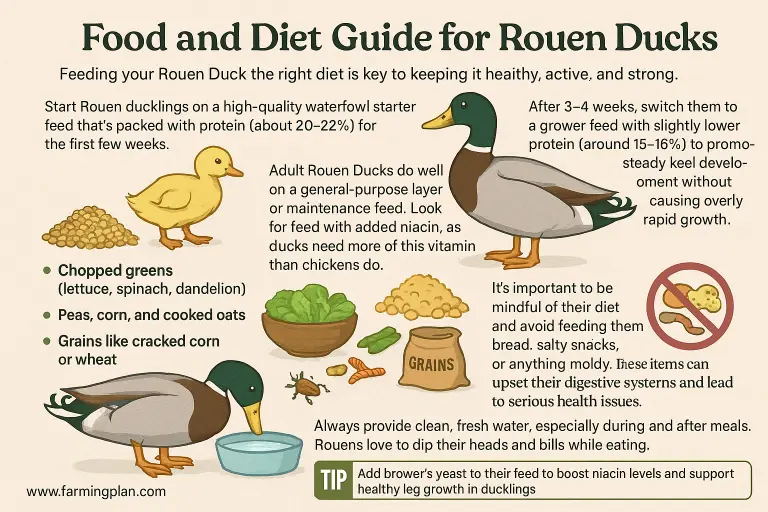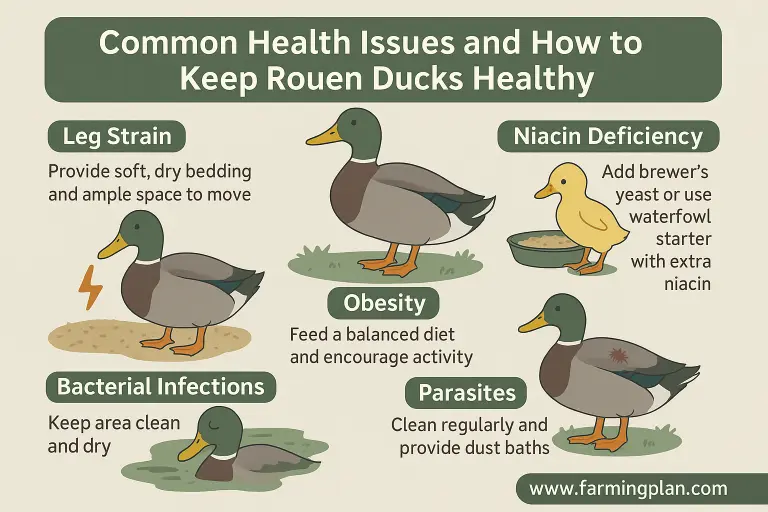The Rouen Duck is a calm, colorful, and heavy domestic duck breed that’s loved by both farmers and pet owners. With its striking green head, deep body, and gentle nature, the Rouen stands out among other duck breeds. Originally bred in France and known for its resemblance to the wild Mallard, this beautiful duck has found its place on farms, in show pens, and in backyard flocks all over the world. Whether you’re raising ducks for meat, looking for a handsome addition to your pond, or just exploring different duck breeds, the Rouen Duck brings beauty, personality, and purpose together in one amazing bird.

History & Origin of the Rouen Duck
The Rouen Duck has a captivating history that begins in north-central France, where it was first bred in the city of Rouen. This beautiful duck was originally developed as a heavier, meatier version of the wild Mallard duck. With careful selective breeding, farmers created a duck that not only looked like the Mallard in color but also had a deeper body, slower growth, and more flavorful meat.
In the 1800s, the breed was brought to England, where it was further refined into two main types: the Standard Rouen (exhibition-typed) and the Production Rouen (common or non-show type). The Standard variety has a deep keel and is often seen in shows, while the Production variety is bred mainly for commercial meat production.

Eventually, Rouens made their way to North America, where they became one of the most popular duck breeds for farms and homesteads. Their handsome appearance and calm nature helped them gain a solid reputation as a general-purpose domesticated duck that’s perfect for both beginners and experienced duck keepers.
Key Characteristics of Rouen Ducks
The Rouen Duck is a large, heavy-bodied bird known for its blocky frame, horizontal carriage, and stunning color patterns. At first glance, it looks similar to a Mallard, but it’s much bigger and has a deeper, fuller chest. One of its most noticeable traits is the deep keel, a fleshy area along the underside that gives the duck its signature shape.
Male Rouen Ducks, often called drakes, have green heads, blue speculum feathers, and brown tail feathers. They also have a white neck ring and a diagonal color pattern on their chests. Female Rouens have a soft dark brown feather pattern with subtle markings that help them blend into their surroundings. These proper color markings are important, especially in exhibition-typed Rouen ducks.
Unlike some duck breeds that stand tall, Rouens have a horizontal body carriage. This trait gives them a grounded, relaxed look. Their feathers are dense and smooth, and their legs are set wide apart to support their massive bodies.
Young Rouen ducklings can be tricky to tell apart from wild mallard ducklings, but they grow much larger and develop thicker bodies over time. Rouens come in two main varieties: the Standard Rouen, used for shows, and the Production Rouen, common on farms for meat. Both types are beautiful in their own way, but the Standard variety tends to have a more handsome, defined shape and a deeper keel.
Reads More: Egg-Bound Chicken Crisis: Act Fast to Protect Your Flock
Temperament and Behavior of the Rouen Duck
The Rouen Duck is known for its gentle, calm, and easygoing personality. These ducks don’t fly well, so they tend to stay close to home, making them perfect for small farms, backyard flocks, and hobby breeders. Their heavy size and relaxed nature mean they’re not skittish or flighty like wild ducks. Rouens enjoy waddling around the yard, dabbling in shallow water, and socializing with other ducks. They are friendly with humans, too, especially if handled gently from a young age. Many owners say their Rouens are quiet, easy to manage, and even a little lazy at times!
Female Rouen ducks are often quieter than other breeds, and their soft quacking makes them a pleasant choice for areas where noise is a concern. Male Rouens are also peaceful and usually get along well with other drakes if raised together. Because of their mild temperament and attractive appearance, Rouens make excellent pet ducks for families, schools, and small homesteads. They’re great for people who want a beautiful duck that’s both calm and useful.
Food and Diet Guide for Rouen Ducks
Feeding your Rouen Duck the right diet is key to keeping it healthy, active, and strong. These ducks have heavier bodies, so they need a well-balanced diet to support their size and slow growth. Start Rouen ducklings on a high-quality waterfowl starter feed that’s packed with protein (about 20–22%) for the first few weeks. After 3–4 weeks, switch them to a grower feed with slightly lower protein (around 15–16%) to promote steady keel development without causing overly rapid growth.

Adult Rouen Ducks do well on a general-purpose layer or maintenance feed. Look for feed with added niacin, as ducks need more of this vitamin than chickens do. You can also give them:
- Chopped greens (lettuce, spinach, dandelion)
- Peas, corn, and cooked oats
- Grains like cracked corn or wheat
- Insects and worms from their foraging
Always provide clean, fresh water, especially during and after meals. Rouens love to dip their heads and bills while eating. It’s important to be mindful of their diet and avoid feeding them bread, salty snacks, or anything moldy. These items can upset their digestive systems and lead to serious health issues. This feeding routine supports both healthy female Rouens for egg production and meaty males for commercial meat purposes.
Tip: “Add brewer’s yeast to their feed to boost niacin levels and support healthy leg growth in ducklings.”
Uses and Purpose of the Rouen Duck
The Rouen Duck is a remarkably versatile bird, cherished for both its beauty and its usefulness. It’s a true general-purpose farm duck, valued in several areas—especially meat production, exhibition, and as a pet.
Rouens are best known as excellent meat birds. Their large size, deep keel, and slow growth give them flavorful meat that’s perfect for roasting. Many farmers raise them for specialized meat markets or home processing. Rouens usually reach an ideal butchering weight at 10–12 weeks, though some let them mature up to 6–8 months for deeper flavor.
In the show world, Exhibition-typed Rouen ducks are prized for their proper color markings, horizontal carriage, and typical duck conformation. Judges look for full keels, wide bodies, and feather patterns that closely match the breed standard.
For pet owners and hobbyists, Rouens are gentle and calm, making them great backyard companions. They’re also useful for egg production, with hens laying about 140–180 eggs per year, usually with a blue-green color. Whether you’re raising ducks for roasting, breeding, or simply enjoying their beauty in the backyard, the Rouen Duck offers a rewarding experience.
“Life is Better with Rouen Ducks: Hardy, Beautiful, and Full of Character!”
Special Features That Make Rouen Ducks Stand Out
The Rouen Duck is more than just a pretty bird. It has several unique traits that set it apart from other domestic duck breeds. One of its most striking features is its color pattern, which closely resembles the wild Mallard—but with a larger, heavier body and a more refined look. Males have a green head, white neck ring, chestnut chest, and a soft gray body, while females show a dark brown feather pattern with proper markings and a rich mixture of colors.
Both sexes have a blue speculum (wing patch) with white borders that add to their beauty. Another special trait is the deep keel, especially in the exhibition-typed Rouens. This full chest gives the duck a solid, upright appearance in shows and makes it perfect for roasting in the kitchen. Rouens also have a horizontal body carriage, unlike upright breeds like runners.
They are hardy ducks that handle cold weather well and are calm enough to mix into many farm setups. Their size, beauty, and blocky body make them the ultimate exhibition duck or a standout in any backyard flock. Rouens also come in handsome varieties like the Apricot Rouen Duck, known for its rare and attractive plumage. These ducks are often chosen for their attractive color patterns, even if not used for meat or eggs.
Reads More: King Pigeon: The Gentle Giant Every Bird Lover Adores
Common Health Issues and How to Keep Rouen Ducks Healthy
Like all domestic ducks, the Rouen Ducks can face a few health problems, but with good care, they stay strong and active. Their heavy bodies and deep keels make them more prone to leg strain or joint issues if raised on hard, slippery surfaces. That’s why it’s important to give them soft, dry bedding and plenty of space to move.

One common issue is niacin deficiency, especially in Rouen ducklings. This can cause weak legs or walking problems. To prevent this, add brewer’s yeast to their feed or use a waterfowl starter with extra niacin. Wet, dirty areas can lead to bacterial infections, especially around the feet and feathers. Always keep their living space clean, with fresh water and dry resting spots. Watch for signs like limping, swollen feet, or discharge from the eyes or nostrils.
Another concern is parasites, like mites or lice, especially in crowded or unclean pens. Regular cleaning and dust baths help prevent infestations. If you see signs of scratching or feather loss, treat quickly with poultry-safe products. Rouens can also struggle with obesity if overfed. Because they aren’t very active, avoid feeding too many grains or treats. Stick to a balanced diet and encourage regular movement. By watching for early symptoms and keeping their space clean and dry, you can protect your Rouens from the most common issues and enjoy a healthy flock.
Step-by-Step Guide to Raising Rouen Ducks
Raising Rouen Ducks is a rewarding experience, whether you’re keeping them for meat, eggs, or simply as lovely pets. Here’s a step-by-step guide to help you get started:
Setting Up Housing for Your Rouens
- Space: Rouens are large ducks that need plenty of room to move around. Provide a spacious pen with access to water for swimming and dabbling. Ideally, each duck should have at least 4-6 square feet of space indoors.
- Shelter: A simple duck house with bedding will keep them dry and protected from the elements. Make sure it’s well-ventilated but draft-free.
- Bedding: Use straw or wood shavings for bedding. Change it regularly to prevent bacterial buildup and maintain cleanliness.
Feeding Your Rouen Ducks
- Ducklings: Start with a waterfowl starter feed for the first few weeks, ensuring the feed has enough protein (around 20-22%) to support their growth.
- Adults: Switch to a layer or maintenance feed for adult ducks, ensuring the diet has the proper balance of protein, fats, and vitamins. Include fresh vegetables and grains to add variety.
- Water: Ducks need fresh water at all times, both for drinking and bathing. Always keep water sources clean.
Ensuring Cleanliness and Hygiene
- Daily Cleaning: Check their water and feed daily. Remove any waste and refill water containers.
- Weekly Cleaning: Once a week, clean out bedding, scrub the water troughs, and inspect for any signs of pests like lice or mites.
- Health Checks: Regularly check their legs, wings, and feathers for any issues such as swelling, parasites, or infections.
Encouraging Natural Behavior
- Foraging: Rouens love to forage for grains, insects, and greens. Allow them to free-range during the day (if safe) to support their natural foraging instincts.
- Water Access: Provide a shallow pond or kiddie pool for dabbling. Rouens enjoy spending time in the water, and it helps keep their feathers clean and healthy.
Caring for Ducklings
- Temperature: Keep ducklings warm for the first few weeks, especially if they are under 6 weeks old. A heat lamp is usually required in colder environments.
- Socializing: Rouens are social ducks. Raise them with others to avoid loneliness. Handle them gently to ensure they become tame and accustomed to people.
Expert Tips and Best Practices for Raising Rouen Ducks
To ensure your Rouen Ducks thrive, here are some expert tips and best practices that can make a big difference in their care:
Prevent Overfeeding
Rouens, particularly males, can become overweight if given too many treats or grains. Their slow growth and heavy build mean they don’t require as much food as some other breeds. Stick to a well-balanced diet and avoid overfeeding them, especially with high-calorie snacks.
Keep Them Active
Since Rouens are not great flyers and tend to be on the lazy side, encourage them to move around and explore. This can be done by providing them with safe areas to roam, or by having them forage for insects and greens, which also keeps them mentally stimulated.
Offer Shade and Fresh Water
During hot weather, make sure your ducks have access to plenty of shade to keep cool. Ducks don’t sweat, so they rely on cool water and shaded areas to regulate their body temperature. Fresh water is especially important not just for drinking but for their bathing habits too.
Regularly Check Their Keels
One of the standout features of Rouen Ducks is their deep keel. Keep an eye on its development, particularly in ducklings. A keel that is too shallow or too deep can be a sign of poor nutrition or improper breeding. If the keel becomes overly developed, it could affect their movement and overall health.
Mix Varieties for a Balanced Flock
If you’re raising more than one breed of duck, consider mixing Rouen Ducks with other breeds, like Apricot Rouen or even Mallards, to create a diverse, healthy flock. This helps prevent inbreeding and ensures good genetic health.
Keep Them Safe from Predators
Rouens are not particularly good at flying, so they are more vulnerable to predators. Use secure fencing, especially at night when predators are more active. Consider keeping them in an enclosed, protected area during the evening to keep them safe.
Where to Buy Rouen Ducks
If you’re looking to add Rouen Ducks to your flock, there are several options available for purchasing both ducklings and adults. Here’s where you can find healthy, purebred Rouen ducks for sale:
Reputable Hatcheries
Many hatcheries offer day-old Rouen ducklings for sale, both online and in person. Look for hatcheries that specialize in waterfowl and have a reputation for healthy ducklings. Some popular hatcheries include:
- Meyer Hatchery
- Cackle Hatchery
- Metzer Farms
These sources usually offer a variety of Rouen ducklings, including female Rouen ducklings and male Rouen ducklings for breeding purposes.
Local Farms and Breeders
For those looking for more personalized care and local options, visiting local farms or breeders is a great idea. Many farmers raise Rouen ducks and sell them in batches or as individual birds. This is a great way to meet the breeder and ensure the ducks are healthy and well cared for.
Online Marketplaces
Websites like Craigslist, eBay, and Facebook Marketplace often have listings for Rouen ducklings for sale or even adult ducks. While these platforms can be hit or miss, you may find good deals from small breeders or farms selling their surplus.
Local Farm Supply Stores
Some farm supply stores that sell poultry may also have Rouen ducklings available, especially during spring when ducklings are in demand. It’s worth checking with your local stores or calling ahead to ask.
Specialty Waterfowl Shows or Fairs
Attending waterfowl shows or poultry fairs can be a great opportunity to find show-quality Rouen ducks. These events often feature Exhibition-typed Rouens, which are raised with careful attention to breed standards.
When purchasing Rouen ducks, always check for:
- Health certificates: Ensure the ducks are disease-free.
- Age-appropriate care: If buying ducklings, make sure they’re at least 1–2 days old and have had proper care.
- Guarantee of breed quality: If you’re seeking purebred ducks, ensure the breeder is reputable and provides accurate information about the breed.
FAQs
What is the egg color of Rouen ducks?
Rouen ducks typically lay white or off-white eggs, though some may produce blue-green eggs. Egg production ranges from 100 to 150 eggs per year, depending on the individual duck and environmental factors.
How do I raise Rouen ducklings?
Provide spacious housing with access to clean water for swimming and drinking. Ensure a balanced diet with appropriate nutrients, and maintain a clean environment to prevent diseases. Regular health checks are essential for early detection of any issues.
Where can I buy Rouen ducks or ducklings?
Reputable hatcheries such as Metzer Farms, Meyer Hatchery, and Murray McMurray Hatchery offer Rouen ducks and ducklings for sale. Local farms and breeders may also have them available. Be sure to check the health and quality of the birds before purchasing.
What is the temperament of Rouen ducks?
Rouen ducks are known for their docile and calm nature, making them suitable for both pets and farm environments. They are less flighty compared to other breeds, which can make handling easier.
How long do Rouen ducks live?
With proper care, Rouen ducks can live up to 9 to 12 years. Factors such as diet, environment, and healthcare play significant roles in their lifespan.
Conclusion
The Rouen Duck is a versatile and hardy breed, prized for its meat quality, docile temperament, and striking appearance. Originating from France, these ducks are excellent foragers and adapt well to various climates. While their egg production is moderate, their large white or off-white eggs are a valuable addition to any flock. Whether you’re interested in raising them for meat, eggs, or as companions, Rouen ducks offer both beauty and utility.

